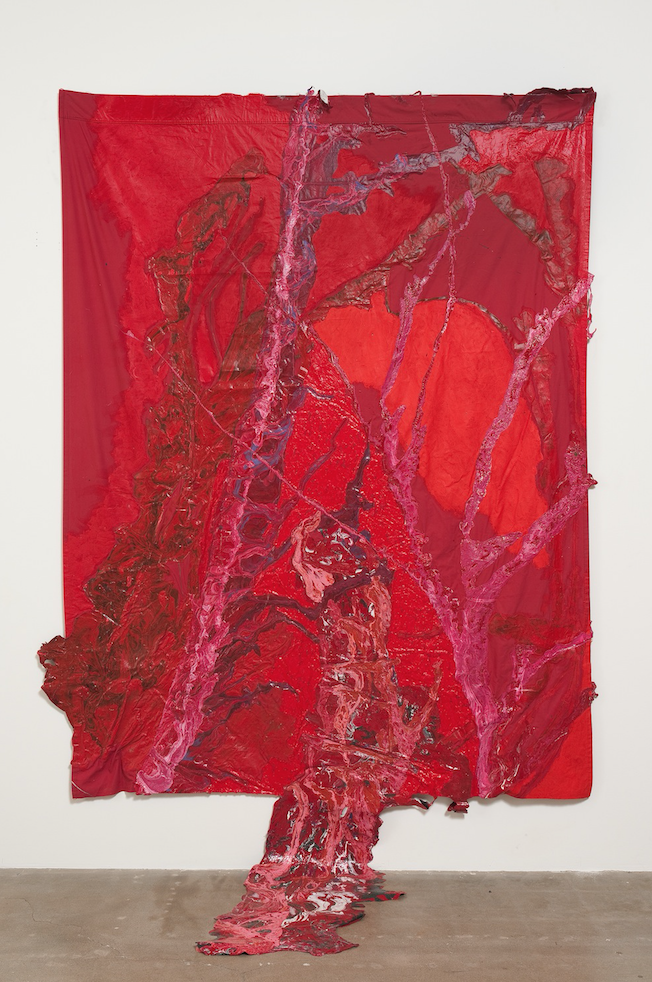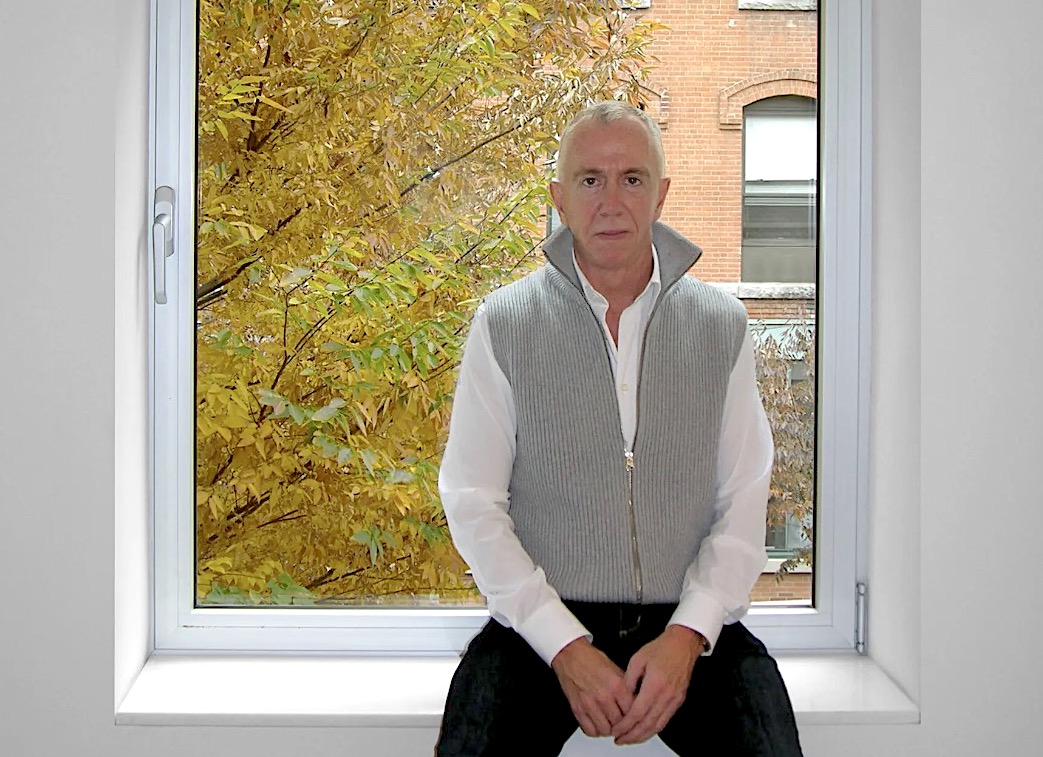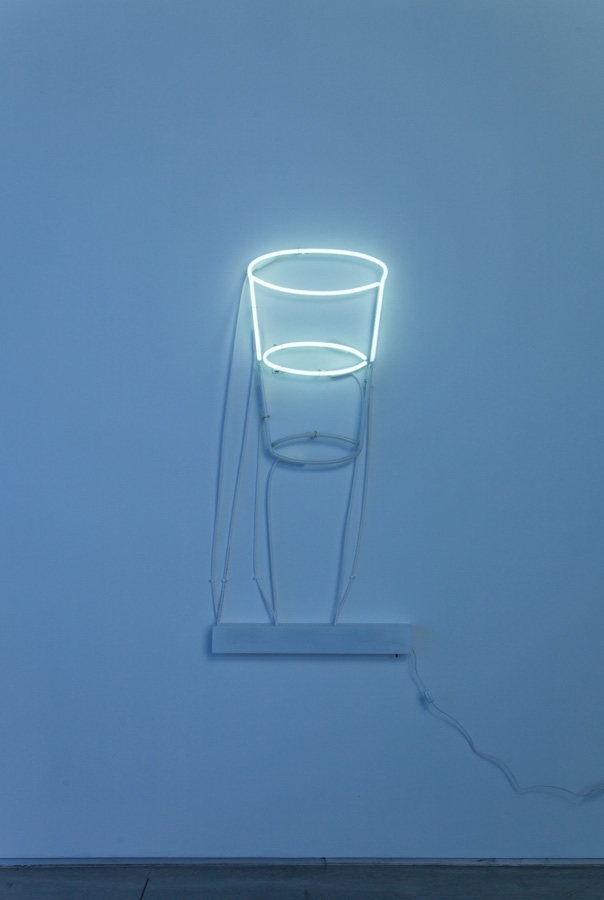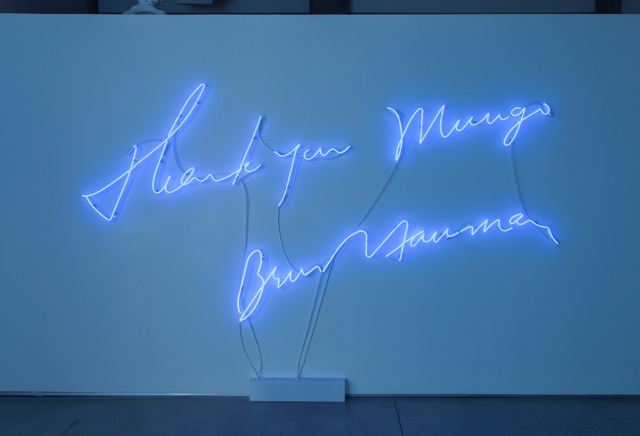
© » KADIST
Igor Grubic
The installation “East Side Story” is based on events that took place in the streets of Belgrade in 2001 and Zagreb in 2002, during the Gay Pride demonstrations, where the participants were the victims of verbal and physical injury by neo-Nazi groups and other citizens. This work is composed of two projections: the first uses television images of the demonstrations while the second is the reconstitution of the events performed by dancers. This piece witnesses nationalism at work in society, aiming particularly at the “internal enemy that sexual minorities might represent”.

© » KADIST
Jonathan Monk
Untitled (rolled up) , is an abstract portrait of Owen Monk, the artist’s father and features an aluminum ring of 56.6 cm in diameter measuring 1.77 cm in circumference, the size of his father. Jonathan Monk bridges a conceptual art and his family privacy, and ironically ensures that there is “no difference between Sol Lewitt and my mother, he does not know more than she do not know. ” What is the status of the O-backed chair rail to the white cube?

© » KADIST
Jonathan Monk
Drawing & Print (Drawing & Print)
Meeting #100 is one in a series of text works by Jonathan Monk. In this series, the artist attempts to organize meetings somewhere in the world. The audience is given the details of a meeting—the place, date and time—and nothing more.

© » KADIST
Kelley Walker
The triptych Black Star Press is part of the series ‘The Black Star Press project’ initiated in 2004 by the American artist Kelley Walker. The images in this series are taken from a photo essay on the struggle for civil rights in Alabama, directed by Charles Moore in 1962 (and published by the magazine ‘Life’) which showed the repression of the black population and persistent inequalities in the southern United States. The title “Black Star Press” is taken from the name of the news agency where Charles Moore worked, and it refers to the young black man shot fighting for the rights of his community.

© » KADIST
Luisa Lambri
Custom-built for a silent film star in 1934 in Santa Monica, the Sten-Frenke House is an idiosyncratic icon. Designed by the architect Richard Neutra, its gray glass, white expanses, and simple forms exude austerity. Luisa Lambri’s photograph Untitled (Sten-Frenke House #04) (2007)recalls the unembellished elegance of the structure while also alluding to modernist painting; the image is less a picture than an abstract expanse that conveys its own flatness.

© » KADIST
Kota Ezawa
The Crime of Art is an animation by Kota Ezawa that appropriates scenes from various popular Hollywood films featuring the theft of artworks: a Monet painting in The Thomas Crown Affair (1999), a Rembrandt in Entrapment (1999), a Cellini in How to Steal a Million (1966), and an emerald encrusted dagger in Topkapi (1964). Ezawa uses his signature cartoon-like style to remix and reenact these crime scenes, leaving only the artworks as “real” objects (as they are depicted in the films), rather than illustrating them. Reversing fiction and reality in an unexpected way, this gesture invites the viewer to question the reliability of the visual footage.

© » KADIST
Kara Walker
In her masterpiece 8 Possible Beginnings or The Creation of African-America , Walker unravels just that, the story of struggle, oppression, escape and the complexities of power dynamics in the history following slave trade in America. Her use of contour and silhouette accentuate emotion with rigor, she reduces the narrative to black and white as gruesome acts of sex and violence address trauma, fear and suffering through a majestic play of shadow and light.

© » KADIST
Luisa Lambri
Lambri’s careful framing in Untitled (Miller House, #02) redefines our understanding of this iconic mid-century modernist building located in Palm Springs, California. Commissioned by industrialist J. Irwin Miller and his wife Xenia Simons Miller, and built by Richard Neutra in 1937, the Miller house’s open and flowing layout expands upon modernist architectural traditions. It features a flat roof, stone and glass walls, with rooms configured beneath a grid pattern of skylights and supporting cruciform steel columns.

© » KADIST
Alicia McCarthy
Drawing & Print (Drawing & Print)
A painting reminiscent of a certain “naive primitivism,” Untitled (the way in is the way out) is representative of McCarthy’s work. Upon first encounter, her abstract colorful compositions resemble somewhat formal nonrepresentational landscapes. However, a closer inspection reveals the presence of a lowbrow style that draws inspiration both from outsider and folk art traditions.

© » KADIST
Alexandre da Cunha
His Deck Painting I recalls the simplistic stripes of conceptual artist Daniel Buren, or the minimal lines of twentieth century abstract painting, but is in reality a readymade, fashioned from repurposed fabric of deck chairs. Alexandre da Cunha reinvents found objects in surprising ways that combine the material characteristics of Arte Povera with the concerns and techniques of painting. Da Cunha’s work often features flags—either as a found material per se or as a constructed form—that reflect the artist’s interest in issues of nationality, governmental politics, allegiance, and culture.

© » KADIST
Luisa Lambri
Rudolph Schindler’s designs, part of a practice he called “Space Architecture,” marry interior with exterior and space with light. The architect’s longtime studio and residence, which he built in Los Angeles in 1922, exemplifies this philosophy, and has since become an influential part of the modernist architectural canon. In Untitled (Schindler House #01) (2007), Luisa Lambri describes Schindler’s studio by capturing its aftereffects—the play of light and shadow cast through branches onto a surface.

© » KADIST
Keith Tyson
The work of Keith Tyson is concerned with an interest in generative systems, and embraces the complexity and interconnectedness of existence. Philosophical problems such as the nature of causality, the roles of probability and design in human experience, and the limits and possibilities of human knowledge, animate much of his work. Language as a coded system, as a representation medium, but also as something that generates a whole variety of realities also plays a central role.

© » KADIST
Rodney McMillian
In his evocative Landscape Paintings, McMillian uses second-hand bedsheets, sourced from thrift shops, as his starting point. Calling up the unknown intimacies of these objects, McMillian upends their usual orientation, placing them directly on the wall to serve as paintings, rather than covers. Layering over the repurposed textiles with hardware store paint, McMillian transforms the sheets into canvases, creating abstract landscapes on top of the traces of human bodies intact in the fabric.

© » KADIST
Igor Grubic
366 Liberation Rituals is a series that gathers a number of actions related to the artist’s micro-politics. They materialize as a plurality of pointers that destabilize reality and interrogate our outlook on the political historicity of former Yugoslavia. These actions were realized over the course of the year the artist turned forty and revolved for one part around the revolutionary movement of 1968 and on the other on the informal group called Grupa šestorice autora (Group of Six Authors)* which was active in Zagreb between 1975 and 1979.

© » KADIST
Alicia McCarthy
Drawing & Print (Drawing & Print)
A painting reminiscent of a certain “naive primitivism,” Untitled (Colors) and Untitled (Ghost) are representative of McCarthy’s work. Upon first encounter, her abstract colorful compositions resemble somewhat formal nonrepresentational landscapes. However, a closer inspection reveals the presence of a lowbrow style that draws inspiration both from outsider and folk art traditions.

© » KADIST
Kota Ezawa
Paint and Unpaint is an animation by Kota Ezawa based on a scene from a popular 1951 film by Hans Namuth featuring Jackson Pollock. At first glance, due to the oversimplified silhouettes Ezawa employs, the connection between his animation and Namuth’s film may not be obvious. However, when seen side by side, Ezawa’s piece is a faithful reproduction of the scene—up until a point in which his sequence begins playing in reverse, effectively unpainting every brushstroke.

© » KADIST
Mungo Thomson
In Thomson’s Untitled (TIME) , every front cover of TIME magazine is sequentially projected to scale at thirty frames per second. In a way, this work both examines the construction of history and the history of the influential magazine, which was founded in 1923. In addition to the play on “time”—one of Thomson’s ongoing obsessions—this piece highlights and continues the artist’s encyclopedic impulse, also seen in The White Album (2008), to record the history of the spaces he inhabits.

© » KADIST
Kota Ezawa
The Simpson Verdict is a three-minute animation by Kota Ezawa that portrays the reading of the verdict during the OJ Simpson trial, known as the “most publicized” criminal trial in history. In 1995, OJ Simpson—a well-known American football player—was accused of the murders of his ex-wife Nicole Brown Simpson and her friend Ronald Goldman. Based on the courtroom footage, Ezawa uses his signature style to create an abstract and graphically simplified echo of what happened in the room.

© » KADIST
Mungo Thomson
Drawing & Print (Drawing & Print)
The White Album (2008) presents a compilation of one hundred issues of Artforum magazine released between 1970 and 1979. As with Will Rogan’s MUM series, also included in the Kadist Collection, vital information is now missing: All of all the articles and features have been removed, leaving only ten years of advertisements. In an unusual way, The White Album reminds us that this important New York-focused magazine was originally founded in 1962 in San Francisco to promote Bay Area artists before it moved to Los Angeles in the mid-1960s in search of a wider advertising base.

© » KADIST
Yao Jui-Chung
Long Long Live (2013) takes the viewer to the setting of the Oasis Villa on Green Island, once a reform and re-education prison to house political prisoners during Taiwan’s martial law period. In black and white, Yao depicts the historical site as an eerie abandoned compound. Reflecting on the centenary of the HsinHai Revolution and the end of the Cold War, Yao questions the existence of an ever lasting dynasty or “transcendental Rules of History.” The soundtrack features a sole voice reverberating through loud speakers.

© » KADIST
Alexandre da Cunha
Glaze (Savana) (2005) is an assemblage of found materials: a car wheel, a tire, and a wooden plinth of the type traditionally used to display sculpture. It directly engages with the readymade, a subject that Alexandre de Cunha takes up throughout his practice, often inflecting it with a tropical, and South American–inspired materiality and painterly style that could potentially come across as a stereotype. Here, da Cunha transforms the component parts into a composition that highlights often-overlooked materials of artistic production and cultural mass-production.

© » KADIST
Shahzia Sikander
The Last Post was inspired by Sikander’s ongoing interest in the colonial history of the sub-continent and the British opium trade with China. In this animation, layers of images, abstract forms, meaning, and metaphorical associations slowly unfold at the same time that more visual myths are created. The identity of the protagonist, a red-coated official, is indeterminate and suggestive of both the mercantilist policies that led to the Opium Wars with China and the cultural authority claimed by the Company school of painting over colonial India.

© » KADIST
Alexandre da Cunha
In Laissez-Faire (Rainbow Flag) da Cunha has turned a beach towel into both a painting and a flag. Where the printed surface of the towel originally served to enliven this commodity, here the pattern—now stretched and re-presented—suddenly refers to abstract painting’s promises of transcendence. And its crisply painted shape pulls the printed colors into the rectangularity of the canvas and, as da Cunha notes, the graphic iconicity of flags.

© » KADIST
Mungo Thomson
Starting with Bruce Nauman’s iconic artwork, The True Artist Helps the World by Revealing Mystic Truths (Window or Wall Sign) , Mungo Thomson’s neon sign is one of a series that replaces Nauman’s quixotic mini-manifesto with aphorisms from ‘recovery’ culture, especially those made popular by alcoholics anonymous. Thomson is referencing the lore that Nauman’s work (the first of many neons he’d make in the following years) had been inspired by a neon beer sign found in a corner-store in San Francisco that he used as his studio in the late 60s. This particular work has a self-critical subtext, as it also suggests the act of using another artist’s work, in an endless spiral of influence, is akin to a form of insanity.

© » KADIST
Alexandre da Cunha
The series West (Flag 1), West (Flag 3), and West (Flag 6) continues da Cunha’s ongoing exploration of the form’s various vertical, horizontal, and diagonal stripes. Here, da Cunha overlays thick bars of color (blue, green, and red) on photographs of the ocean at sunset with surfers in floating on the horizon. The solid colors contrast with the fading colors reflected in the sunset, and the tilted orientation suggests a familiar California beach scene.
Mungo Thomson
- location: Los Angeles, California
- year born: 1969
- gender: male
- nationality: American
Jonathan Monk
- location: Berlin, Germany
- year born: 1969
- gender: male
- nationality: British
- home town: Leicester, United Kingdom
Alexandre da Cunha
- location: London, United Kingdom
- year born: 1969
- gender: male
- nationality: Brazilian
- home town: Rio de Janeiro, Brazil
Kota Ezawa
- location: San Francisco, California
- year born: 1969
- gender: male
- nationality: German
- home town: Cologne, Germany
Luisa Lambri
- location: Los Angeles, California
- year born: 1969
- gender: female
- nationality: Italian
- home town: Como, Italy
Igor Grubic
- location: Zagreb, Hrvatska
- year born: 1969
- gender: male
- nationality: Croatian
Kara Walker
- location: New York, New York
- year born: 1969
- gender: female
- nationality: American
- home town: Stockton, California
Alicia McCarthy
- location: Oakland, California
- year born: 1969
- gender: female
- nationality: American
- home town: Oakland, California
Shahzia Sikander
- location: New York
- location: Texas
- year born: 1969
- gender: female
- nationality: Pakistani-American
- home town: Lahore, Pakistan
Rodney McMillian
- location: Los Angeles, California
- year born: 1969
- gender: male
- nationality: American
- home town: Columbia, South Carolina
Keith Tyson
- location: Ulverston, United Kingdom
- year born: 1969
- gender: male
- nationality: British
Yao Jui-Chung
- year born: 1969
- gender: male
- nationality: Taiwanese
- home town: Taipei, Taiwan
Kelley Walker
- location: Columbus, United States
- year born: 1969
- gender: male
- nationality: American

© » ARTLYST
about 3 months ago (01/17/2024)
Brent Sikkema, the Manhattan art dealer renowned for representing artists such as Jeffrey Gibson and Kara Walker found dead The post Brent Sikkema – Visionary Art Dealer Of Jeffrey Gibson And Kara Walker Murdered appeared first on Artlyst ....
-
2000-2009
Luisa Lambri
2002Lambri’s careful framing in Untitled (Miller House, #02) redefines our understanding of this iconic mid-century modernist building located in Palm Springs, California...
Kota Ezawa
2002The Simpson Verdict is a three-minute animation by Kota Ezawa that portrays the reading of the verdict during the OJ Simpson trial, known as the “most publicized” criminal trial in history...
Jonathan Monk
2003Untitled (rolled up) , is an abstract portrait of Owen Monk, the artist’s father and features an aluminum ring of 56.6 cm in diameter measuring 1.77 cm in circumference, the size of his father...
Kelley Walker
2004The triptych Black Star Press is part of the series ‘The Black Star Press project’ initiated in 2004 by the American artist Kelley Walker...
Kara Walker
2005In her masterpiece 8 Possible Beginnings or The Creation of African-America , Walker unravels just that, the story of struggle, oppression, escape and the complexities of power dynamics in the history following slave trade in America...
Alexandre da Cunha
2005His Deck Painting I recalls the simplistic stripes of conceptual artist Daniel Buren, or the minimal lines of twentieth century abstract painting, but is in reality a readymade, fashioned from repurposed fabric of deck chairs...
Alexandre da Cunha
2005Glaze (Savana) (2005) is an assemblage of found materials: a car wheel, a tire, and a wooden plinth of the type traditionally used to display sculpture...
Luisa Lambri
2007Custom-built for a silent film star in 1934 in Santa Monica, the Sten-Frenke House is an idiosyncratic icon...
Luisa Lambri
2007Rudolph Schindler’s designs, part of a practice he called “Space Architecture,” marry interior with exterior and space with light...
Igor Grubic
2008366 Liberation Rituals is a series that gathers a number of actions related to the artist’s micro-politics...
Mungo Thomson
Drawing & Print
2008(Drawing & Print) The White Album (2008) presents a compilation of one hundred issues of Artforum magazine released between 1970 and 1979...
-
2010-2019
Alicia McCarthy
Drawing & Print
2010(Drawing & Print) A painting reminiscent of a certain “naive primitivism,” Untitled (the way in is the way out) is representative of McCarthy’s work...
Alicia McCarthy
Drawing & Print
2010(Drawing & Print) A painting reminiscent of a certain “naive primitivism,” Untitled (Colors) and Untitled (Ghost) are representative of McCarthy’s work...
Mungo Thomson
2010In Thomson’s Untitled (TIME) , every front cover of TIME magazine is sequentially projected to scale at thirty frames per second...
Shahzia Sikander
2010The Last Post was inspired by Sikander’s ongoing interest in the colonial history of the sub-continent and the British opium trade with China...
Alexandre da Cunha
2010In Laissez-Faire (Rainbow Flag) da Cunha has turned a beach towel into both a painting and a flag...
Alexandre da Cunha
2011The series West (Flag 1), West (Flag 3), and West (Flag 6) continues da Cunha’s ongoing exploration of the form’s various vertical, horizontal, and diagonal stripes...
Igor Grubic
2013The installation “East Side Story” is based on events that took place in the streets of Belgrade in 2001 and Zagreb in 2002, during the Gay Pride demonstrations, where the participants were the victims of verbal and physical injury by neo-Nazi groups and other citizens...
Rodney McMillian
2013In his evocative Landscape Paintings, McMillian uses second-hand bedsheets, sourced from thrift shops, as his starting point...
Yao Jui-Chung
2013Long Long Live (2013) takes the viewer to the setting of the Oasis Villa on Green Island, once a reform and re-education prison to house political prisoners during Taiwan’s martial law period...
Kota Ezawa
2014Paint and Unpaint is an animation by Kota Ezawa based on a scene from a popular 1951 film by Hans Namuth featuring Jackson Pollock...
Mungo Thomson
2014Starting with Bruce Nauman’s iconic artwork, The True Artist Helps the World by Revealing Mystic Truths (Window or Wall Sign) , Mungo Thomson’s neon sign is one of a series that replaces Nauman’s quixotic mini-manifesto with aphorisms from ‘recovery’ culture, especially those made popular by alcoholics anonymous...
Kota Ezawa
2017The Crime of Art is an animation by Kota Ezawa that appropriates scenes from various popular Hollywood films featuring the theft of artworks: a Monet painting in The Thomas Crown Affair (1999), a Rembrandt in Entrapment (1999), a Cellini in How to Steal a Million (1966), and an emerald encrusted dagger in Topkapi (1964)...



